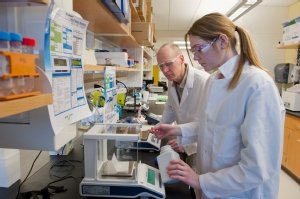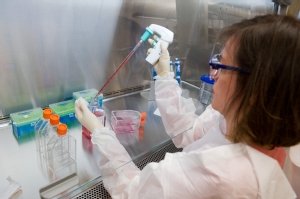Building new forensics tools
Scientist plans to study molecular fingerprints of toxic agents

Within weeks of the 9/11 terrorist attacks, a series of anthrax-laced letters were mailed from Princeton, N.J. to news organizations and U.S. senators. The country’s first major, bioterrorist attack killed five people and sickened 17 others from Connecticut to Florida, temporarily shut down U.S. mail processing centers, and forced the evacuation of federal buildings.
Although the FBI closed the case in 2008 after its primary suspect committed suicide, critics of the massive investigation, including the National Academy of Sciences, say scientific analyses of the evidence and the FBI conclusions were flawed. Eleven years and millions of dollars later, the case remains mired in controversy and unresolved—no evidence directly linked the suspect to the anthrax.
But what if the FBI had a better scientific tool? Would the outcome have changed if investigators had a genetic marker or molecular fingerprint for anthrax that could determine if the suspect had been exposed to the toxin?
That is exactly the kind of tool Kevin Sweder hopes to build. Sweder is the director of the Center for Bioforensics, Biosecurity, and Biometrics, the research unit of the Forensics and National Security Sciences Institute, which is housed in Syracuse University's College of Arts and Sciences. Sweder studies proteins that repair damaged DNA.
DNA contains the molecular instructions for every physiological process that occurs in living organisms. The DNA is compacted and organized as chromatin within the cell nucleus around proteins called histones. When a piece of DNA is damaged, cells dispatch tiny molecular troubleshooters to find and remove the damage. Damage that is not removed or repaired can lead to a diseased state, such as cancer. Likewise, some genetic disorders are caused by a defect in the DNA repair process.
Although the FBI closed the case in 2008 after its primary suspect committed suicide, critics of the massive investigation, including the National Academy of Sciences, say scientific analyses of the evidence and the FBI conclusions were flawed. Eleven years and millions of dollars later, the case remains mired in controversy and unresolved—no evidence directly linked the suspect to the anthrax.
But what if the FBI had a better scientific tool? Would the outcome have changed if investigators had a genetic marker or molecular fingerprint for anthrax that could determine if the suspect had been exposed to the toxin?
That is exactly the kind of tool Kevin Sweder hopes to build. Sweder is the director of the Center for Bioforensics, Biosecurity, and Biometrics, the research unit of the Forensics and National Security Sciences Institute, which is housed in Syracuse University's College of Arts and Sciences. Sweder studies proteins that repair damaged DNA.
DNA contains the molecular instructions for every physiological process that occurs in living organisms. The DNA is compacted and organized as chromatin within the cell nucleus around proteins called histones. When a piece of DNA is damaged, cells dispatch tiny molecular troubleshooters to find and remove the damage. Damage that is not removed or repaired can lead to a diseased state, such as cancer. Likewise, some genetic disorders are caused by a defect in the DNA repair process.

When DNA is damaged by exposure to sunlight (ultraviolet radiation) or other environmental conditions, changes occur to the histones (called epigenetic changes) in response to the event. In the case of ultraviolet radiation, these epigenetic changes signal repair proteins and help them find the damaged area. Similarly, when cells are exposed to physical, chemical, or biological agents, cells respond by changing cellular processes that lead to epigenetic changes. The epigenetic changes can be tracked through subsequent generations of cell division, a key factor in Sweder’s research.
“Conceivably, one could analyze the genes for these histone modifications to determine if someone was exposed to anthrax or other agents, including nuclear radiation, long after the agent is gone,” Sweder says. “The system could be used to determine substances to which soldiers have been exposed on the battlefield, or if suspects believed to have manufactured the agent were exposed.”
Most scientific research is focused on looking at the histone changes as a means for treating disease or genetic defects. Sweder is almost alone in focusing on the feasibility of using these changes as molecular fingerprints. The work is in its early stages. Sweder and his research associate, JoAnne Race, must first develop the process for identifying specific histone modifications associated with DNA damage. They are growing yeast and mammalian cells in the laboratory and will compare their histone modifications in the normal state with modifications that occur after the cells are exposed to ultraviolet radiation or other agents.
“Our goal is to figure out the epigenetic changes involved with DNA repair, how long-lived those changes are, and the genetic markers we need to look at that are specific for UV exposure,” Sweder says. “That’s the basic science part of our research. If successful, the information can be applied to developing new forensics tools for detecting exposure to specific toxins or for developing ways to minimize the effects of toxins on exposed populations.”
“Conceivably, one could analyze the genes for these histone modifications to determine if someone was exposed to anthrax or other agents, including nuclear radiation, long after the agent is gone,” Sweder says. “The system could be used to determine substances to which soldiers have been exposed on the battlefield, or if suspects believed to have manufactured the agent were exposed.”
Most scientific research is focused on looking at the histone changes as a means for treating disease or genetic defects. Sweder is almost alone in focusing on the feasibility of using these changes as molecular fingerprints. The work is in its early stages. Sweder and his research associate, JoAnne Race, must first develop the process for identifying specific histone modifications associated with DNA damage. They are growing yeast and mammalian cells in the laboratory and will compare their histone modifications in the normal state with modifications that occur after the cells are exposed to ultraviolet radiation or other agents.
“Our goal is to figure out the epigenetic changes involved with DNA repair, how long-lived those changes are, and the genetic markers we need to look at that are specific for UV exposure,” Sweder says. “That’s the basic science part of our research. If successful, the information can be applied to developing new forensics tools for detecting exposure to specific toxins or for developing ways to minimize the effects of toxins on exposed populations.”
Media Contact
Judy Holmes
